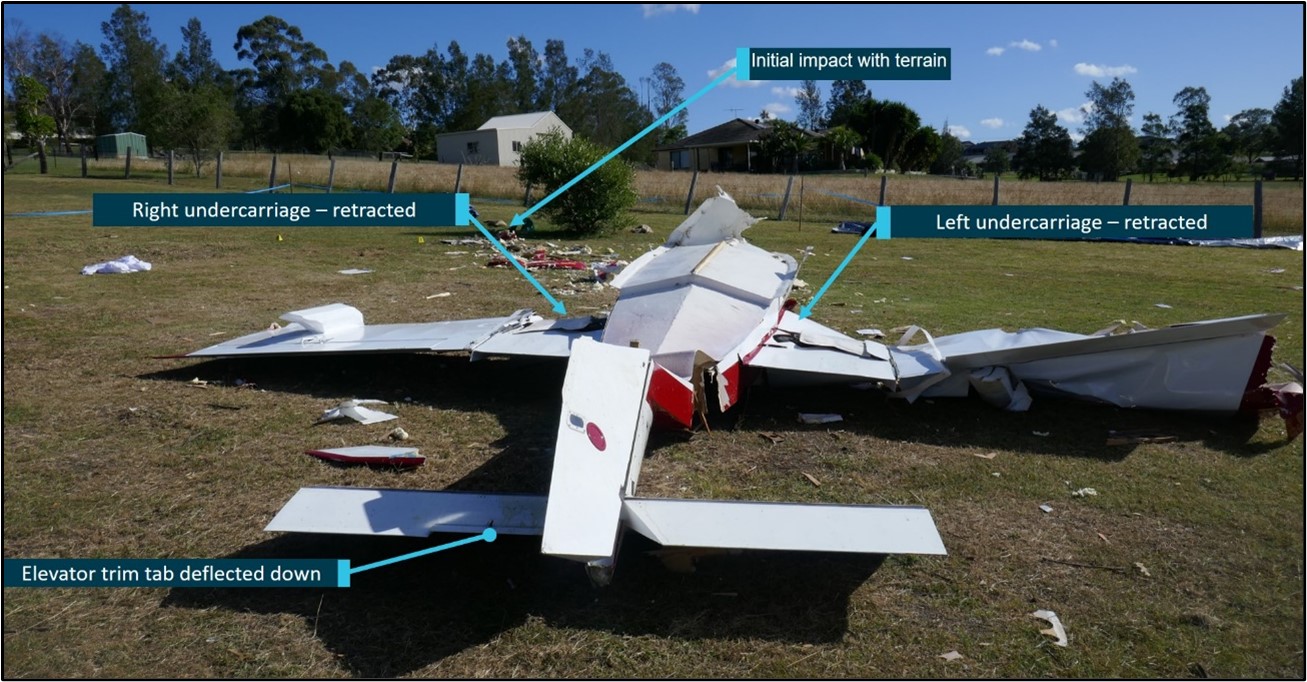
|
Key points:
|
The ATSB’s investigation into a fatal accident involving an Osprey 2 aircraft at Maitland Airport, NSW highlights both the complex nature of managing a partial power loss and the importance of good engineering practices for amateur built aircraft.
The aircraft, built by private builders from plans under the provisions of the amateur-built experimental aircraft system, took off from Maitland Airport on 17 May 2020 for the pilot’s second test flight in the aircraft.
While passing through 2,400 ft, the pilot was advised via radio that the aircraft’s engine was producing white smoke. The pilot noted the engine was not running smoothly.
The pilot broadcast their intention to return to land on runway 23, but during descent turned to join the reciprocal runway 05.
As the aircraft turned onto the base leg of the circuit, the engine failed completely, and the pilot attempted to conduct a forced landing on the closer runway 08.
“During the final stage of the glide approach, the aircraft was observed to abruptly roll, pitch down and collide with the ground,” ATSB Director Transport Safety Stuart Macleod said.
The pilot was fatally injured, and the aircraft was destroyed.
Video from the cockpit showed the airspeed decreased to between 60–65 kt prior to the roll, and examination of the accident site confirmed the aircraft contacted the ground with low forward airspeed while rolling to the left, consistent with an aerodynamic stall.
The ATSB found the use of a damaged engine oil cooler fitting, which was not compatible with the fitted oil hose, most likely resulted in the hose disconnecting from the oil cooler during the climb and the engine’s loss of oil.
“A partial loss of engine power event of this kind is a more complex scenario for a pilot to face than complete engine power loss,” Mr Macleod said.
“Pilots can be strongly influenced by the fact the engine is still providing some power, and often by the strong desire to return the aircraft to the runway to avoid damaging the aircraft in a forced landing,” he explained.
“In this case the pilot’s decision to change from runway 23 to runway 05 meant the aircraft needed to stay airborne longer, necessitating more power from the damaged engine to maintain height.”
The ATSB found this extended airborne duration, and need for increased engine power, resulted in the engine failing due to oil starvation.
“Pilots are reminded that a partial engine failure often precedes a complete loss of power,” Mr Macleod continued.
“In the event of a partial loss of power, the aircraft should be landed at the earliest possible opportunity and consideration should be given to forced landing options along the flight path.”
The investigation also identified that the required, and the majority of the recommended, build inspections of the aircraft were not conducted, and this was not detected prior to the issuance of a certificate of airworthiness that permitted the aircraft to be flown.
“While these inspections would probably not have detected the damaged oil cooler fitting, they may have identified the oil supply hose was in poor condition,” Mr Macleod said.
“They would also have been an opportunity to identify and improve the overall build quality of the aircraft.”
The ATSB also identified a number of other deficiencies relating to the inspection and flight testing of amateur-built aircraft, including the risk assessment of the proposed test pilot.
“This accident also highlights the importance of adhering to the design specifications and good engineering practices when building an amateur-built experimental aircraft,” Mr Macleod said.
“Attention should be given to the component manufacturer’s specifications, installation instructions and limitations to ensure the component, and consequently the aircraft, will perform as intended.”
The ATSB notes the Civil Aviation Safety Authority (CASA)’s proposed Part 43 regulation includes new guidance for amateur-built aircraft, to revise the current rules, which were last updated in September 2000.
Read the final report: Collision with terrain involving amateur-built Osprey 2 amphibian aircraft, registered VH-WID near Maitland Airport, New South Wales on 17 May 2020


